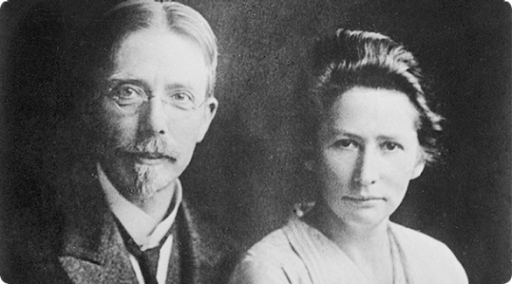August and Marie Krogh
In the early 1920s when Frederick Banting and Charles Best’s insulin research was gaining international attention, a Danish couple would realize the value of this life-saving medicine. Both Marie and August Krogh went on to play an important role in making sure this drug was available to people living with diabetes in Nordic countries.
Born in 1874, Marie Jorgensen was one of nine children. Unfortunately, five of her siblings died of tuberculosis before reaching adulthood. This tragedy may have inspired Marie to pursue physiology and medicine, as her dissertation in medical school examined gas diffusion in the lungs.
At the University of Copenhagen, Marie earned her doctorate in medicine, becoming the fourth Danish woman to do so. While in medical school, Marie met August Krogh, and fell in love. The couple were married a year later in 1905. To support their academic careers, Marie opened a medical practice after graduating and worked as a doctor. She also continued to research lung diffusion, as well as metabolism and the role of the thyroid in metabolic regulation.
August Krogh was born in November 1874 in Grenå, Denmark. The son of a shipbuilder, August attended the University of Copenhagen where he studied medicine, zoology, and physiology. After meeting Marie, August would collaborate with her on gas exchange and the flow of oxygen throughout the body. August discovered that oxygen flow is regulated by small blood vessels known as capillaries. When the body is at rest, many capillaries are closed. During exertion, the capillaries open, allowing more oxygen to be delivered to the muscles. For this discovery, August was awarded the Nobel Prize in Physiology or Medicine in 1920.
After winning the Nobel Prize, August travelled to the United States where he gave lectures at universities along the east coast. Upon hearing of the diabetes research that was happening in Canada, Marie convinced August to stop at the University of Toronto. Marie was living with diabetes herself and was interested in Banting and Best’s discovery of insulin.
August immediately understood the importance of insulin. He obtained the rights to manufacture the drug in Nordic countries. Upon his return to Denmark, August and Marie started a company to manufacture the drug. Marie was among the first to test the newly produced insulin. The company started by the Kroghs would eventually become Novo Nordisk. Today, Novo Nordisk is an international pharmaceutical company that continues to produce insulin, along with many other drugs, as well as conduct diabetes research.
August and Marie passed on their legacy of academic education and love of science to their children. Their youngest daughter, Bodil Schmidt-Nielsen, became an eminent physiologist and would later become the first female president of the American Physiological Society. Marie and August supported each other throughout their scientific careers, and changed the lives of Danish people living with diabetes.
— Written by Shivani Seth

